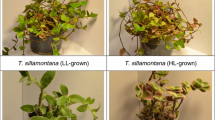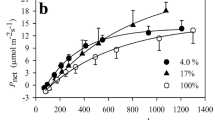Abstract
Geum montanum L. is an alpine plant usually found at altitudes between 1700 and 2600 m. Its wintergreen leaves can be subjected to very low temperatures and at the same time receive high photon flux densities at the beginning of the growth season when the snow melts. We report results of a study, performed with classical methods of biophysics, showing that leaves of G. montanum were remarkably tolerant to sunlight even at low temperatures. This tolerance results from the interplay of photorespiration and CO2 photosassimilation. When temperatures approach 0°C, responses include stomatal opening and CO2 uptake even under desiccation stress. This permits linear electron transport that is sufficient to avoid the excessive reduction of the electron transport chain which is known to lead to photodamage. In addition, excitation energy was shifted from photosystem (PS)II to PSI which is a very efficient energy quencher. Sensitivity of P700 in PSI to oxidation by far-red light was decreased and rates of dark reduction of photooxidized P700 were increased by actinic illumination, suggesting activation of cyclic electron transport. Consistent with this, far-red light was able to decrease the quantum yield of PSII (measured by the F v/F m ratio of chlorophyll fluorescence). We suggest that cyclic electron transport decreases the lumenal pH under strong light. In the presence of zeaxanthin, this increases energy dissipation at the PSII level. At low temperatures, P700 remained strongly oxidized under high irradiation while the primary electron acceptor of PSII, QA, was largely reduced. This shows efficient control of electron transport presumably at the level of the cytochrome b/f complex and suggests formation of a protective transthylakoid proton gradient even when linear electron transport is much reduced in the cold. Thus, several mechanisms cooperate to effectively protect the photosynthetic apparatus of G. montanum from photodamage. We see no indication of destructive “photostress” in this species during the growth season under alpine low-temperature and drought conditions.
Similar content being viewed by others
Author information
Authors and Affiliations
Additional information
Received: 2 March 1998 / Accepted: 7 January 1999
Rights and permissions
About this article
Cite this article
Manuel, N., Cornic, G., Aubert, S. et al. Protection against photoinhibition in the alpine plant Geum montanum . Oecologia 119, 149–158 (1999). https://doi.org/10.1007/s004420050771
Issue Date:
DOI: https://doi.org/10.1007/s004420050771




